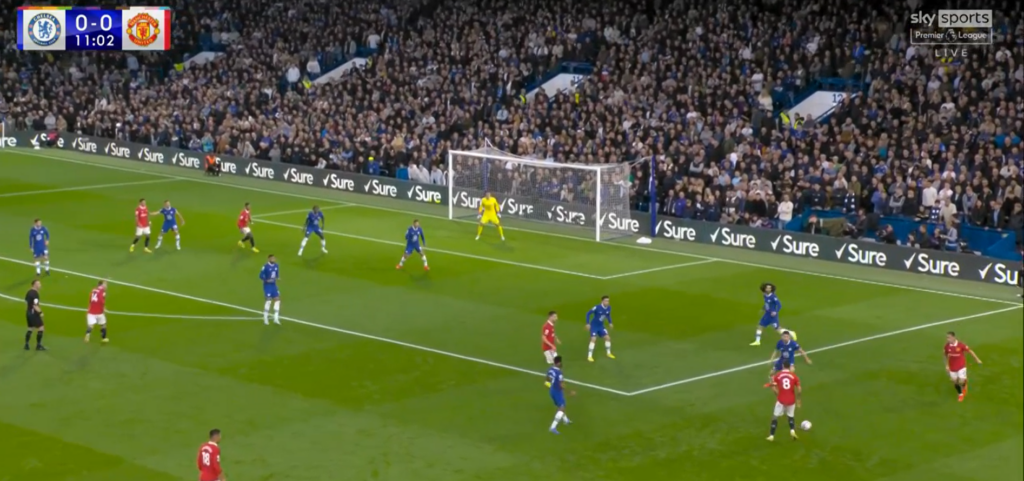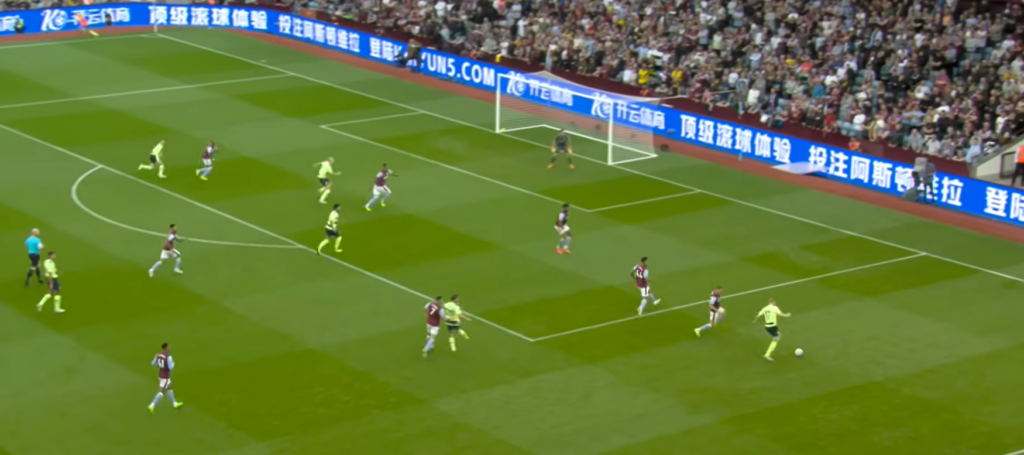
Donny van de Beek’s cameos at Manchester United have been largely uninspiring, even under the coach who made his name known worldwide.
He has never been able to get going at United, with fans often criticising him for being too passing and not offering anything in possession.
There is some credence to this, Van de Beek is an entirely different type of #10 to Bruno Fernandes, who United’s team has been built around since he joined, in that he does not force the issue or look to play creative passes at every opportunity, instead doing more of his work off the ball.
The one thing that has not been considered though is the fact that he doesn’t often actually get passed to. Not because he is hiding from the ball though, he actually does the complete opposite. The Dutchman consistently makes quite high-value runs that are consistently ignored. Against Nottingham Forest, however, one instance really stood out.


Here, Alejandro Garnacho found Donny van de Beek’s run in the channel, releases him inside the box, and Donny has a chance to cut it back to Marcus Rashford. These runs, and those cutbacks, are key facets of Erik ten Hag’s play at Manchester United and they are of great help to the wingers in possession, supporting them when they are doubled up on.
This situation is a transition, with Aurier close behind him Garnacho cannot slow down. His only option if Donny does not make the run is to take on Worrall. In this instance, Garnacho probably could have done this successfully, sure. We’ve seen his talent already, and just how dangerous he is up against players. But under Erik ten Hag, United’s offensive play is not predicated on transitions, it is more controlled possession and so the wingers are not often receiving dynamically, with momentum on their side up against double teams.
I raise another example of a Manchester United winger facing a double team, this time in a more settled state of possession. Here, Jadon Sancho receives possession wide on the left against Arsenal at Old Trafford, one of his best performances from his debut season.




See the difference one simple run here made? Sancho faced a triple team and was able to eliminate three players from the match because of the run made by his Brazilian teammate. Rashford’s movement, too, made a difference, and he would have been a good option if Fred had not been there. But Fred made a run into the channel and was able to create a very high-value shot because of it. Sancho excels at finding these runs.


Here, a similar situation. This time Sancho does not have an overlapping run to support him, but Fred’s run from deep allows him to again beat the double team with a pass, without the run he would have struggled to do this as almost all players do when in this situation. Fred wins a penalty, but if he had not been fouled he would again have had an opportunity for a cutback and an opportunity to create another high-value shot.
Sancho has often been criticised for ‘not taking on his man’, and at times he has been too passive on the dribble, this is true. Recent reports of him struggling mentally would offer an explanation for this, although that is a different conversation entirely. Back to the point, the majority of situations he faces are double teams. This is normal for wingers in possession systems.
Here, from United’s opening game of this season against Brighton, Marcus Rashford faces up against a double-team on the left-hand side, with another Brighton defender tracking back closely. Here, however, Rashford has no support at all and is forced to take on the double team, losing possession in the process.

This sequence of play, on the right-hand side this time, is a good example of why these over/underlapping runs are needed.


So far so good, right? Here is where Fernandes makes his mistake. In this instance, the optimal run for him to make is behind Cucurella, where Antony can find him in a good position to play a cutback for Rashford or any other players attacking the box. Instead, he does the following:



I now raise an example from a situation on Manchester City’s right-wing, from which Kevin De Bruyne creates a goal.


This situation is not quite the same, but see the value of the Belgian’s movement here. Had he not made the run then Bernardo would have either had to go it alone or slow down the attack. For all his qualities on the ball that are rightfully praised, De Bruyne is constantly running off the ball to try and create space for himself and his teammates, it also drags defenders around which distorts opposition blocks.
His relentless search for space in final-third possessions is part of what makes him one of the most prolific creators English football has ever seen. Below is an example of his movement from the 2019/20 season


Here comes an example from another possession-dominant team whose wingers are often found on the touchline. Arsenal’s Bukayo Saka receives on the touchline, and Martin Ødegaard’s movement leads to an opportunity.


Finally, two examples from Ten Hag’s Ajax side which showcase the importance of both cutbacks and these runs, and these examples involve two current United players. The first is a goal from Antony, against Borussia Dortmund in last season’s UEFA Champions League, where the shot is created by movement.



The next example is a Donny van de Beek assist against Bayern Munich in 2018/19, which is not similar to other situations in this article as it is not coming from very wide but his run behind the defence and cutback is a goal that very much personifies an Erik ten Hag side.


Donny van de Beek looks set to miss the rest of the season following his injury against Everton. It is a shame because he was starting to better show the qualities he brings to United’s team as the side progresses under Ten Hag. But other members of the squad can still learn from him to make this team better.
United’s wingers possess remarkable creative qualities. Jadon Sancho had back-to-back-to-back 20-assist seasons for Borussia Dortmund, and Ten Hag did not insist on splashing out such a sum on Antony for no reason. If you watch back clips of Ajax last season, one of the Brazilian’s strengths is finding underlapping runs.
The team has been built solely to facilitate Bruno Fernandes’ creative quality for a while. Up until now, he has delivered. But if United want to level up as a team under Ten Hag then creativity in open play must be coming from more than one source, and the alternate sources are right there. United just need a couple of changes to their offensive play to bring the best out of them.